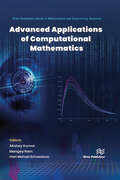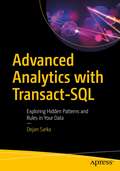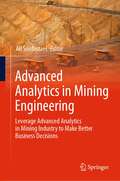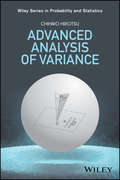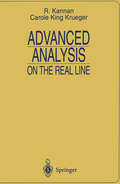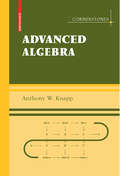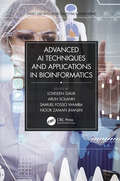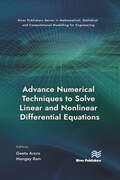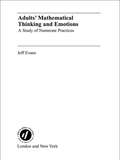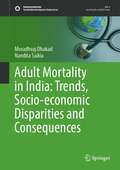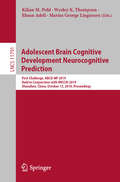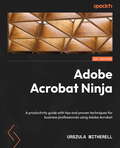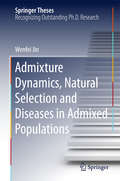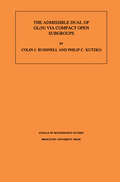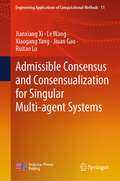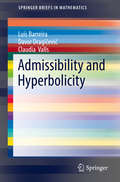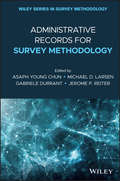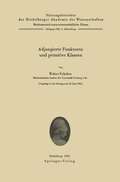- Table View
- List View
Advanced Applications of Computational Mathematics: Theoretical Advances And Advanced Applications (De Gruyter Series On The Applications Of Mathematics In Engineering And Information Sciences Ser. #3)
by Akshay Kumar Mangey Ram Hari Mohan SrivastavaThis book “Advanced Applications of Computational Mathematics” covers multidisciplinary studies containing advanced research in the field of computational and applied mathematics. The book includes research methodology, techniques, applications, and algorithms. The book will be very useful to advanced students, researchers and practitioners who are involved in the areas of computational and applied mathematics and engineering.
Advanced Applications of Computational Mathematics
This book “Advanced Applications of Computational Mathematics” covers multidisciplinary studies containing advanced research in the field of computational and applied mathematics. The book includes research methodology, techniques, applications, and algorithms. The book will be very useful to advanced students, researchers and practitioners who are involved in the areas of computational and applied mathematics and engineering.
Advanced Analytics with Transact-SQL: Exploring Hidden Patterns and Rules in Your Data
by Dejan SarkaLearn about business intelligence (BI) features in T-SQL and how they can help you with data science and analytics efforts without the need to bring in other languages such as R and Python. This book shows you how to compute statistical measures using your existing skills in T-SQL. You will learn how to calculate descriptive statistics, including centers, spreads, skewness, and kurtosis of distributions. You will also learn to find associations between pairs of variables, including calculating linear regression formulas and confidence levels with definite integration. No analysis is good without data quality. Advanced Analytics with Transact-SQL introduces data quality issues and shows you how to check for completeness and accuracy, and measure improvements in data quality over time. The book also explains how to optimize queries involving temporal data, such as when you search for overlapping intervals. More advanced time-oriented information in the book includes hazard and survival analysis. Forecasting with exponential moving averages and autoregression is covered as well. Every web/retail shop wants to know the products customers tend to buy together. Trying to predict the target discrete or continuous variable with few input variables is important for practically every type of business. This book helps you understand data science and the advanced algorithms use to analyze data, and terms such as data mining, machine learning, and text mining.Key to many of the solutions in this book are T-SQL window functions. Author Dejan Sarka demonstrates efficient statistical queries that are based on window functions and optimized through algorithms built using mathematical knowledge and creativity. The formulas and usage of those statistical procedures are explained so you can understand and modify the techniques presented. T-SQL is supported in SQL Server, Azure SQL Database, and in Azure Synapse Analytics. There are so many BI features in T-SQL that it might become your primary analytic database language. If you want to learn how to get information from your data with the T-SQL language that you already are familiar with, then this is the book for you. What You Will LearnDescribe distribution of variables with statistical measuresFind associations between pairs of variablesEvaluate the quality of the data you are analyzingPerform time-series analysis on your dataForecast values of a continuous variablePerform market-basket analysis to predict customer purchasing patternsPredict target variable outcomes from one or more input variablesCategorize passages of text by extracting and analyzing keywordsWho This Book Is ForDatabase developers and database administrators who want to translate their T-SQL skills into the world of business intelligence (BI) and data science. For readers who want to analyze large amounts of data efficiently by using their existing knowledge of T-SQL and Microsoft’s various database platforms such as SQL Server and Azure SQL Database. Also for readers who want to improve their querying by learning new and original optimization techniques.
Advanced Analytics in Mining Engineering: Leverage Advanced Analytics in Mining Industry to Make Better Business Decisions
by Ali SoofastaeiIn this book, Dr. Soofastaei and his colleagues reveal how all mining managers can effectively deploy advanced analytics in their day-to-day operations- one business decision at a time.Most mining companies have a massive amount of data at their disposal. However, they cannot use the stored data in any meaningful way. The powerful new business tool-advanced analytics enables many mining companies to aggressively leverage their data in key business decisions and processes with impressive results.From statistical analysis to machine learning and artificial intelligence, the authors show how many analytical tools can improve decisions about everything in the mine value chain, from exploration to marketing.Combining the science of advanced analytics with the mining industrial business solutions, introduce the “Advanced Analytics in Mining Engineering Book” as a practical road map and tools for unleashing the potential buried in your company’s data.The book is aimed at providing mining executives, managers, and research and development teams with an understanding of the business value and applicability of different analytic approaches and helping data analytics leads by giving them a business framework in which to assess the value, cost, and risk of potential analytical solutions. In addition, the book will provide the next generation of miners – undergraduate and graduate IT and mining engineering students – with an understanding of data analytics applied to the mining industry. By providing a book with chapters structured in line with the mining value chain, we will provide a clear, enterprise-level view of where and how advanced data analytics can best be applied. This book highlights the potential to interconnect activities in the mining enterprise better. Furthermore, the book explores the opportunities for optimization and increased productivity offered by better interoperability along the mining value chain – in line with the emerging vision of creating a digital mine with much-enhanced capabilities for modeling, simulation, and the use of digital twins – in line with leading “digital” industries.
Advanced Analysis of Variance (Wiley Series in Probability and Statistics #384)
by Chihiro HirotsuIntroducing a revolutionary new model for the statistical analysis of experimental data In this important book, internationally acclaimed statistician, Chihiro Hirotsu, goes beyond classical analysis of variance (ANOVA) model to offer a unified theory and advanced techniques for the statistical analysis of experimental data. Dr. Hirotsu introduces the groundbreaking concept of advanced analysis of variance (AANOVA) and explains how the AANOVA approach exceeds the limitations of ANOVA methods to allow for global reasoning utilizing special methods of simultaneous inference leading to individual conclusions. Focusing on normal, binomial, and categorical data, Dr. Hirotsu explores ANOVA theory and practice and reviews current developments in the field. He then introduces three new advanced approaches, namely: testing for equivalence and non-inferiority; simultaneous testing for directional (monotonic or restricted) alternatives and change-point hypotheses; and analyses emerging from categorical data. Using real-world examples, he shows how these three recognizable families of problems have important applications in most practical activities involving experimental data in an array of research areas, including bioequivalence, clinical trials, industrial experiments, pharmaco-statistics, and quality control, to name just a few. • Written in an expository style which will encourage readers to explore applications for AANOVA techniques in their own research • Focuses on dealing with real data, providing real-world examples drawn from the fields of statistical quality control, clinical trials, and drug testing • Describes advanced methods developed and refined by the author over the course of his long career as research engineer and statistician • Introduces advanced technologies for AANOVA data analysis that build upon the basic ANOVA principles and practices Introducing a breakthrough approach to statistical analysis which overcomes the limitations of the ANOVA model, Advanced Analysis of Variance is an indispensable resource for researchers and practitioners working in fields within which the statistical analysis of experimental data is a crucial research component. Chihiro Hirotsu is a Senior Researcher at the Collaborative Research Center, Meisei University, and Professor Emeritus at the University of Tokyo. He is a fellow of the American Statistical Association, an elected member of the International Statistical Institute, and he has been awarded the Japan Statistical Society Prize (2005) and the Ouchi Prize (2006). His work has been published in Biometrika, Biometrics, and Computational Statistics & Data Analysis, among other premier research journals.
Advanced Analysis of Variance (Wiley Series in Probability and Statistics)
by Chihiro HirotsuIntroducing a revolutionary new model for the statistical analysis of experimental data In this important book, internationally acclaimed statistician, Chihiro Hirotsu, goes beyond classical analysis of variance (ANOVA) model to offer a unified theory and advanced techniques for the statistical analysis of experimental data. Dr. Hirotsu introduces the groundbreaking concept of advanced analysis of variance (AANOVA) and explains how the AANOVA approach exceeds the limitations of ANOVA methods to allow for global reasoning utilizing special methods of simultaneous inference leading to individual conclusions. Focusing on normal, binomial, and categorical data, Dr. Hirotsu explores ANOVA theory and practice and reviews current developments in the field. He then introduces three new advanced approaches, namely: testing for equivalence and non-inferiority; simultaneous testing for directional (monotonic or restricted) alternatives and change-point hypotheses; and analyses emerging from categorical data. Using real-world examples, he shows how these three recognizable families of problems have important applications in most practical activities involving experimental data in an array of research areas, including bioequivalence, clinical trials, industrial experiments, pharmaco-statistics, and quality control, to name just a few. • Written in an expository style which will encourage readers to explore applications for AANOVA techniques in their own research • Focuses on dealing with real data, providing real-world examples drawn from the fields of statistical quality control, clinical trials, and drug testing • Describes advanced methods developed and refined by the author over the course of his long career as research engineer and statistician • Introduces advanced technologies for AANOVA data analysis that build upon the basic ANOVA principles and practices Introducing a breakthrough approach to statistical analysis which overcomes the limitations of the ANOVA model, Advanced Analysis of Variance is an indispensable resource for researchers and practitioners working in fields within which the statistical analysis of experimental data is a crucial research component. Chihiro Hirotsu is a Senior Researcher at the Collaborative Research Center, Meisei University, and Professor Emeritus at the University of Tokyo. He is a fellow of the American Statistical Association, an elected member of the International Statistical Institute, and he has been awarded the Japan Statistical Society Prize (2005) and the Ouchi Prize (2006). His work has been published in Biometrika, Biometrics, and Computational Statistics & Data Analysis, among other premier research journals.
Advanced Analysis: on the Real Line (Universitext)
by R. Kannan Carole K. Krueger- < f is increasing. The latter part of the book deals with functions of bounded variation and approximately continuous functions. Finally there is an exhaustive chapter on the generalized Cantor sets and Cantor functions. The bibliography is extensive and a great variety of exercises serves to clarify and sometimes extend the results presented in the text.
Advanced Algebra (Cornerstones)
by Anthony W. KnappBasic Algebra and Advanced Algebra systematically develop concepts and tools in algebra that are vital to every mathematician, whether pure or applied, aspiring or established. Advanced Algebra includes chapters on modern algebra which treat various topics in commutative and noncommutative algebra and provide introductions to the theory of associative algebras, homological algebras, algebraic number theory, and algebraic geometry. Many examples and hundreds of problems are included, along with hints or complete solutions for most of the problems. Together the two books give the reader a global view of algebra and its role in mathematics as a whole.
Advanced AI Techniques and Applications in Bioinformatics (Smart and Intelligent Computing in Engineering)
by Loveleen Gaur Arun Solanki Samuel Fosso Wamba Noor Zaman JhanjhiThe advanced AI techniques are essential for resolving various problematic aspects emerging in the field of bioinformatics. This book covers the recent approaches in artificial intelligence and machine learning methods and their applications in Genome and Gene editing, cancer drug discovery classification, and the protein folding algorithms among others. Deep learning, which is widely used in image processing, is also applicable in bioinformatics as one of the most popular artificial intelligence approaches. The wide range of applications discussed in this book are an indispensable resource for computer scientists, engineers, biologists, mathematicians, physicians, and medical informaticists. Features: Focusses on the cross-disciplinary relation between computer science and biology and the role of machine learning methods in resolving complex problems in bioinformatics Provides a comprehensive and balanced blend of topics and applications using various advanced algorithms Presents cutting-edge research methodologies in the area of AI methods when applied to bioinformatics and innovative solutions Discusses the AI/ML techniques, their use, and their potential for use in common and future bioinformatics applications Includes recent achievements in AI and bioinformatics contributed by a global team of researchers
Advanced AI Techniques and Applications in Bioinformatics (Smart and Intelligent Computing in Engineering)
by Loveleen Gaur, Arun Solanki, Samuel Fosso Wamba and Noor Zaman JhanjhiThe advanced AI techniques are essential for resolving various problematic aspects emerging in the field of bioinformatics. This book covers the recent approaches in artificial intelligence and machine learning methods and their applications in Genome and Gene editing, cancer drug discovery classification, and the protein folding algorithms among others. Deep learning, which is widely used in image processing, is also applicable in bioinformatics as one of the most popular artificial intelligence approaches. The wide range of applications discussed in this book are an indispensable resource for computer scientists, engineers, biologists, mathematicians, physicians, and medical informaticists. Features: Focusses on the cross-disciplinary relation between computer science and biology and the role of machine learning methods in resolving complex problems in bioinformatics Provides a comprehensive and balanced blend of topics and applications using various advanced algorithms Presents cutting-edge research methodologies in the area of AI methods when applied to bioinformatics and innovative solutions Discusses the AI/ML techniques, their use, and their potential for use in common and future bioinformatics applications Includes recent achievements in AI and bioinformatics contributed by a global team of researchers
Advance Numerical Techniques to Solve Linear and Nonlinear Differential Equations (River Publishers Series in Mathematical, Statistical and Computational Modelling for Engineering)
by Geeta Arora Mangey RamReal-world issues can be translated into the language and concepts of mathematics with the use of mathematical models. Models guided by differential equations with intuitive solutions can be used throughout engineering and the sciences. Almost any changing system may be described by a set of differential equations. They may be found just about anywhere you look in fields including physics, engineering, economics, sociology, biology, business, healthcare, etc. The nature of these equations has been investigated by several mathematicians over the course of hundreds of years and, consequently, numerous effective methods for solving them have been created. It is often impractical to find a purely analytical solution to a system described by a differential equation because either the system itself is too complex or the system being described is too vast. Numerical approaches and computer simulations are especially helpful in such systems. The content provided in this book involves real-world examples, explores research challenges in numerical treatment, and demonstrates how to create new numerical methods for resolving problems. Theories and practical applications in the sciences and engineering are also discussed. Students of engineering and applied mathematics, as well as researchers and engineers who use computers to solve problems numerically or oversee those who do, will find this book focusing on advance numerical techniques to solve linear and nonlinear differential equations useful.
Advance Numerical Techniques to Solve Linear and Nonlinear Differential Equations (River Publishers Series in Mathematical, Statistical and Computational Modelling for Engineering)
Real-world issues can be translated into the language and concepts of mathematics with the use of mathematical models. Models guided by differential equations with intuitive solutions can be used throughout engineering and the sciences. Almost any changing system may be described by a set of differential equations. They may be found just about anywhere you look in fields including physics, engineering, economics, sociology, biology, business, healthcare, etc. The nature of these equations has been investigated by several mathematicians over the course of hundreds of years and, consequently, numerous effective methods for solving them have been created. It is often impractical to find a purely analytical solution to a system described by a differential equation because either the system itself is too complex or the system being described is too vast. Numerical approaches and computer simulations are especially helpful in such systems. The content provided in this book involves real-world examples, explores research challenges in numerical treatment, and demonstrates how to create new numerical methods for resolving problems. Theories and practical applications in the sciences and engineering are also discussed. Students of engineering and applied mathematics, as well as researchers and engineers who use computers to solve problems numerically or oversee those who do, will find this book focusing on advance numerical techniques to solve linear and nonlinear differential equations useful.
Adults' Mathematical Thinking and Emotions: A Study of Numerate Practice
by Jeff EvansThe crisis around teaching and learning of mathematics and its use in everyday life and work relate to a number of issues. These include: The doubtful transferability of school maths to real life contexts, the declining participation in A level and higher education maths courses, the apparent exclusion of some groups, such as women and the aversion of many people to maths. This book addresses these issues by considering a number of key problems in maths education and numeracy:*differences among social groups, especially those related to gender and social class*the inseparability of cognition and emotion in mathematical activity*the understanding of maths anxiety in traditional psychological, psychoanalytical and feminist theories*how adults' numerate thinking and performance must be understood in context.The author's findings have practical applications in education and training, such as clarifying problems of the transfer of learning, and of countering maths anxiety.
Adults' Mathematical Thinking and Emotions: A Study of Numerate Practice (Studies In Mathematics Education Ser.)
by Jeff EvansThe crisis around teaching and learning of mathematics and its use in everyday life and work relate to a number of issues. These include: The doubtful transferability of school maths to real life contexts, the declining participation in A level and higher education maths courses, the apparent exclusion of some groups, such as women and the aversion of many people to maths. This book addresses these issues by considering a number of key problems in maths education and numeracy:*differences among social groups, especially those related to gender and social class*the inseparability of cognition and emotion in mathematical activity*the understanding of maths anxiety in traditional psychological, psychoanalytical and feminist theories*how adults' numerate thinking and performance must be understood in context.The author's findings have practical applications in education and training, such as clarifying problems of the transfer of learning, and of countering maths anxiety.
Adult Mortality in India: Trends, Socio-economic Disparities and Consequences (Sustainable Development Goals Series)
by Moradhvaj Dhakad Nandita SaikiaThis volume provides a comprehensive overview of the adult mortality situation in India. Each chapter ranges from general adult mortality patterns to its consequences in India. It discusses data-related challenges to studying adult mortality and examines the level, trends, and changing patterns, whether convergence or divergence of adult mortality across the regions from 1981 to 2015. Analyzing the mortality risk across different socioeconomic groups of the population in India, it examines the major underlying causes of adult death with a detailed analysis of external causes of death. The volume enhances the reader's understanding of adult health situations through the lenses of gender, caste, religion, rural-urban, economic status, and region of residence, and its severe consequences at the household level. It is a valuable addition to knowledge on demography, epidemiology, health economics, applied statistics, and public health studies worldwide. It is a must-reference work for Master's and Ph.D. scholars to explore India's and low- and middle-income countries' mortality situations.
Adolescent Brain Cognitive Development Neurocognitive Prediction: First Challenge, ABCD-NP 2019, Held in Conjunction with MICCAI 2019, Shenzhen, China, October 13, 2019, Proceedings (Lecture Notes in Computer Science #11791)
by Kilian M. Pohl Wesley K. Thompson Ehsan Adeli Marius George LinguraruThis book constitutes the refereed proceedings of the First Challenge in Adolescent Brain Cognitive Development Neurocognitive Prediction, ABCD-NP 2019, held in conjunction with MICCAI 2019, in Shenzhen, China, in October 2019. 29 submissions were carefully reviewed and 24 of them were accepted. Some of the 24 submissions were merged and resulted in the 21 papers that are presented in this book. The papers explore methods for predicting fluid intelligence from T1-weighed MRI of 8669 children (age 9-10 years) recruited by the Adolescent Brain Cognitive Development Study (ABCD) study; the largest long-term study of brain development and child health in the United States to date.
Adobe Acrobat Ninja: A Productivity Guide With Tips And Proven Techniques For Business Professionals Using Adobe Acrobat
by Urszula WitherellA productivity guide with tips and proven techniques for business professionals using Adobe Acrobat
Admixture Dynamics, Natural Selection and Diseases in Admixed Populations (Springer Theses)
by Wenfei JinIn this thesis, Dr. Jin presents the distribution of ancestral chromosomal segments in the admixed genome, which could provide the information needed to explore population admixture dynamics. The author derives accurate population histories of African Americans and Mexicans using genome-wide single nucleotide polymorphisms (SNPs) data. Mapping the genetic background facilitates the study of natural selection in the admixed population, and the author identifies the signals of selection in African Americans since their African ancestors left for America. He further demonstrates that many of the selection signals were associated with African American-specific high-risk diseases such as prostate cancer and hypertension, suggesting an important role these disease-related genes might have played in adapting to their new environment. Lastly, the author reveals the complexity of natural selection in shaping human susceptibility to disease. The thesis significantly advances our understanding of the recent population admixture, adaptation to local environment and its health implications.
The Admissible Dual of GL(N) via Compact Open Subgroups. (AM-129), Volume 129
by C. Bushnell P. C. KutzkoThis work gives a full description of a method for analyzing the admissible complex representations of the general linear group G = Gl(N,F) of a non-Archimedean local field F in terms of the structure of these representations when they are restricted to certain compact open subgroups of G. The authors define a family of representations of these compact open subgroups, which they call simple types. The first example of a simple type, the "trivial type," is the trivial character of an Iwahori subgroup of G. The irreducible representations of G containing the trivial simple type are classified by the simple modules over a classical affine Hecke algebra. Via an isomorphism of Hecke algebras, this classification is transferred to the irreducible representations of G containing a given simple type. This leads to a complete classification of the irreduc-ible smooth representations of G, including an explicit description of the supercuspidal representations as induced representations. A special feature of this work is its virtually complete reliance on algebraic methods of a ring-theoretic kind. A full and accessible account of these methods is given here.
Admissible Consensus and Consensualization for Singular Multi-agent Systems (Engineering Applications of Computational Methods #11)
by Jianxiang Xi Le Wang Xiaogang Yang Jiuan Gao Ruitao LuThis book explores admissible consensus analysis and design problems concerning singular multi-agent systems, addressing various impact factors including time delays, external disturbances, switching topologies, protocol states, topology structures, and performance constraint. It also discusses the state-space decomposition method, a key technique that can decompose the motions of singular multi-agent systems into two parts: the relative motion and the whole motion. The relative motion is independent of the whole motion. Further, it describes the admissible consensus analysis and determination of the design criteria for different impact factors using the Lyapunov method, the linear matrix inequality tool, and the generalized Riccati equation method. This book is a valuable reference resource for graduate students of control theory and engineering and researchers in the field of multi-agent systems.
Admissibility and Hyperbolicity (SpringerBriefs in Mathematics)
by Luís Barreira Davor Dragičević Claudia VallsThis book gives a comprehensive overview of the relationship between admissibility and hyperbolicity. Essential theories and selected developments are discussed with highlights to applications. The dedicated readership includes researchers and graduate students specializing in differential equations and dynamical systems (with emphasis on hyperbolicity) who wish to have a broad view of the topic and working knowledge of its techniques. The book may also be used as a basis for appropriate graduate courses on hyperbolicity; the pointers and references given to further research will be particularly useful.The material is divided into three parts: the core of the theory, recent developments, and applications. The first part pragmatically covers the relation between admissibility and hyperbolicity, starting with the simpler case of exponential contractions. It also considers exponential dichotomies, both for discrete and continuous time, and establishes corresponding results building on the arguments for exponential contractions. The second part considers various extensions of the former results, including a general approach to the construction of admissible spaces and the study of nonuniform exponential behavior. Applications of the theory to the robustness of an exponential dichotomy, the characterization of hyperbolic sets in terms of admissibility, the relation between shadowing and structural stability, and the characterization of hyperbolicity in terms of Lyapunov sequences are given in the final part.
Administrative Records for Survey Methodology (Wiley Series in Survey Methodology)
by Asaph Young Chun Michael D. Larsen Gabriele Durrant Jerome P. ReiterAddresses the international use of administrative records for large-scale surveys, censuses, and other statistical purposes Administrative Records for Survey Methodology is a comprehensive guide to improving the quality, cost-efficiency, and interpretability of surveys and censuses using administrative data research. Contributions from a team of internationally-recognized experts provide practical approaches for integrating administrative data in statistical surveys, and discuss the methodological issues—including concerns of privacy, confidentiality, and legality—involved in collecting and analyzing administrative records. Numerous real-world examples highlight technological and statistical innovations, helping readers gain a better understanding of both fundamental methods and advanced techniques for controlling data quality reducing total survey error. Divided into four sections, the first describes the basics of administrative records research and addresses disclosure limitation and confidentiality protection in linked data. Section two focuses on data quality and linking methodology, covering topics such as quality evaluation, measuring and controlling for non-consent bias, and cleaning and using administrative lists. The third section examines the use of administrative records in surveys and includes case studies of the Swedish register-based census and the administrative records applications used for the US 2020 Census. The book’s final section discusses combining administrative and survey data to improve income measurement, enhancing health surveys with data linkage, and other uses of administrative data in evidence-based policymaking. This state-of-the-art resource: Discusses important administrative data issues and suggests how administrative data can be integrated with more traditional surveys Describes practical uses of administrative records for evidence-driven decisions in both public and private sectors Emphasizes using interdisciplinary methodology and linking administrative records with other data sources Explores techniques to leverage administrative data to improve the survey frame, reduce nonresponse follow-up, assess coverage error, mesaure linkage non-consent bias, and perform small area estimation. Administrative Records for Survey Methodology is an indispensable reference and guide for statistical researchers and methodologists in academia, industry, and government, particularly census bureaus and national statistical offices, and an ideal supplemental text for undergraduate and graduate courses in data science, survey methodology, data collection, and data analysis methods.
Administrative Records for Survey Methodology (Wiley Series in Survey Methodology)
by Asaph Young Chun Michael D. Larsen Gabriele Durrant Jerome P. ReiterAddresses the international use of administrative records for large-scale surveys, censuses, and other statistical purposes Administrative Records for Survey Methodology is a comprehensive guide to improving the quality, cost-efficiency, and interpretability of surveys and censuses using administrative data research. Contributions from a team of internationally-recognized experts provide practical approaches for integrating administrative data in statistical surveys, and discuss the methodological issues—including concerns of privacy, confidentiality, and legality—involved in collecting and analyzing administrative records. Numerous real-world examples highlight technological and statistical innovations, helping readers gain a better understanding of both fundamental methods and advanced techniques for controlling data quality reducing total survey error. Divided into four sections, the first describes the basics of administrative records research and addresses disclosure limitation and confidentiality protection in linked data. Section two focuses on data quality and linking methodology, covering topics such as quality evaluation, measuring and controlling for non-consent bias, and cleaning and using administrative lists. The third section examines the use of administrative records in surveys and includes case studies of the Swedish register-based census and the administrative records applications used for the US 2020 Census. The book's final section discusses combining administrative and survey data to improve income measurement, enhancing health surveys with data linkage, and other uses of administrative data in evidence-based policymaking. This state-of-the-art resource: Discusses important administrative data issues and suggests how administrative data can be integrated with more traditional surveys Describes practical uses of administrative records for evidence-driven decisions in both public and private sectors Emphasizes using interdisciplinary methodology and linking administrative records with other data sources Explores techniques to leverage administrative data to improve the survey frame, reduce nonresponse follow-up, assess coverage error, mesaure linkage non-consent bias, and perform small area estimation. Administrative Records for Survey Methodology is an indispensable reference and guide for statistical researchers and methodologists in academia, industry, and government, particularly census bureaus and national statistical offices, and an ideal supplemental text for undergraduate and graduate courses in data science, survey methodology, data collection, and data analysis methods.
